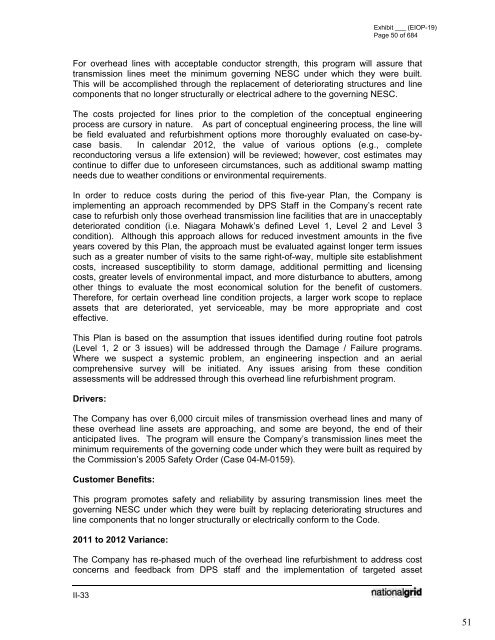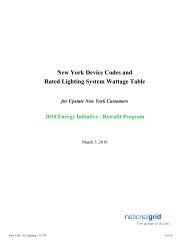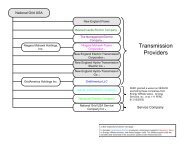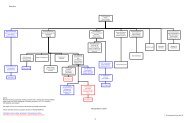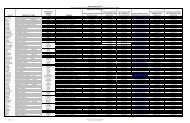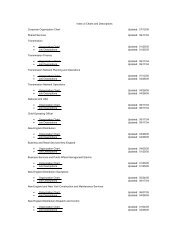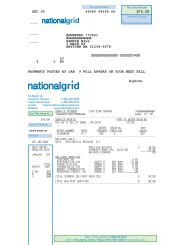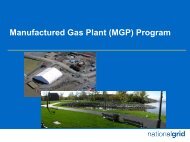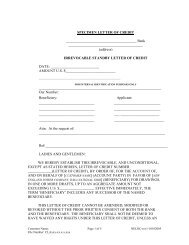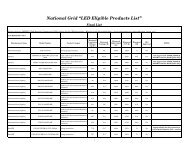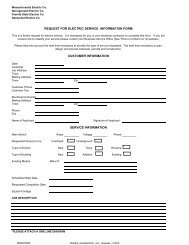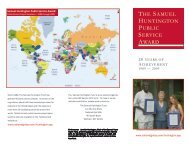January 2012 Capital Investment - National Grid
January 2012 Capital Investment - National Grid
January 2012 Capital Investment - National Grid
You also want an ePaper? Increase the reach of your titles
YUMPU automatically turns print PDFs into web optimized ePapers that Google loves.
Exhibit ___ (EIOP-19)Page 50 of 684For overhead lines with acceptable conductor strength, this program will assure thattransmission lines meet the minimum governing NESC under which they were built.This will be accomplished through the replacement of deteriorating structures and linecomponents that no longer structurally or electrical adhere to the governing NESC.The costs projected for lines prior to the completion of the conceptual engineeringprocess are cursory in nature. As part of conceptual engineering process, the line willbe field evaluated and refurbishment options more thoroughly evaluated on case-bycasebasis. In calendar <strong>2012</strong>, the value of various options (e.g., completereconductoring versus a life extension) will be reviewed; however, cost estimates maycontinue to differ due to unforeseen circumstances, such as additional swamp mattingneeds due to weather conditions or environmental requirements.In order to reduce costs during the period of this five-year Plan, the Company isimplementing an approach recommended by DPS Staff in the Company’s recent ratecase to refurbish only those overhead transmission line facilities that are in unacceptablydeteriorated condition (i.e. Niagara Mohawk’s defined Level 1, Level 2 and Level 3condition). Although this approach allows for reduced investment amounts in the fiveyears covered by this Plan, the approach must be evaluated against longer term issuessuch as a greater number of visits to the same right-of-way, multiple site establishmentcosts, increased susceptibility to storm damage, additional permitting and licensingcosts, greater levels of environmental impact, and more disturbance to abutters, amongother things to evaluate the most economical solution for the benefit of customers.Therefore, for certain overhead line condition projects, a larger work scope to replaceassets that are deteriorated, yet serviceable, may be more appropriate and costeffective.This Plan is based on the assumption that issues identified during routine foot patrols(Level 1, 2 or 3 issues) will be addressed through the Damage / Failure programs.Where we suspect a systemic problem, an engineering inspection and an aerialcomprehensive survey will be initiated. Any issues arising from these conditionassessments will be addressed through this overhead line refurbishment program.Drivers:The Company has over 6,000 circuit miles of transmission overhead lines and many ofthese overhead line assets are approaching, and some are beyond, the end of theiranticipated lives. The program will ensure the Company’s transmission lines meet theminimum requirements of the governing code under which they were built as required bythe Commission’s 2005 Safety Order (Case 04-M-0159).Customer Benefits:This program promotes safety and reliability by assuring transmission lines meet thegoverning NESC under which they were built by replacing deteriorating structures andline components that no longer structurally or electrically conform to the Code.2011 to <strong>2012</strong> Variance:The Company has re-phased much of the overhead line refurbishment to address costconcerns and feedback from DPS staff and the implementation of targeted assetII-3351


